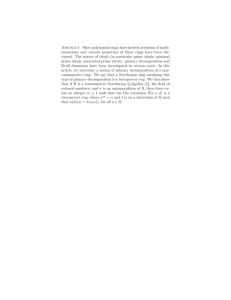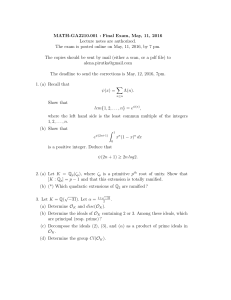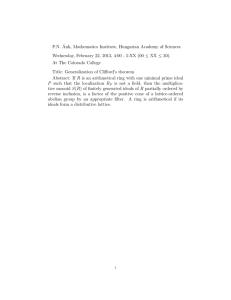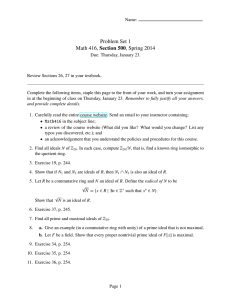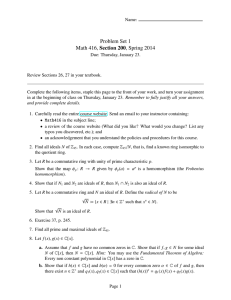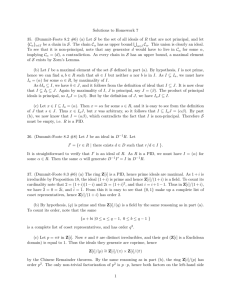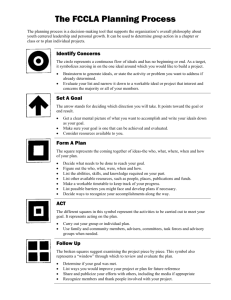Math 538: Problem Set 2
advertisement
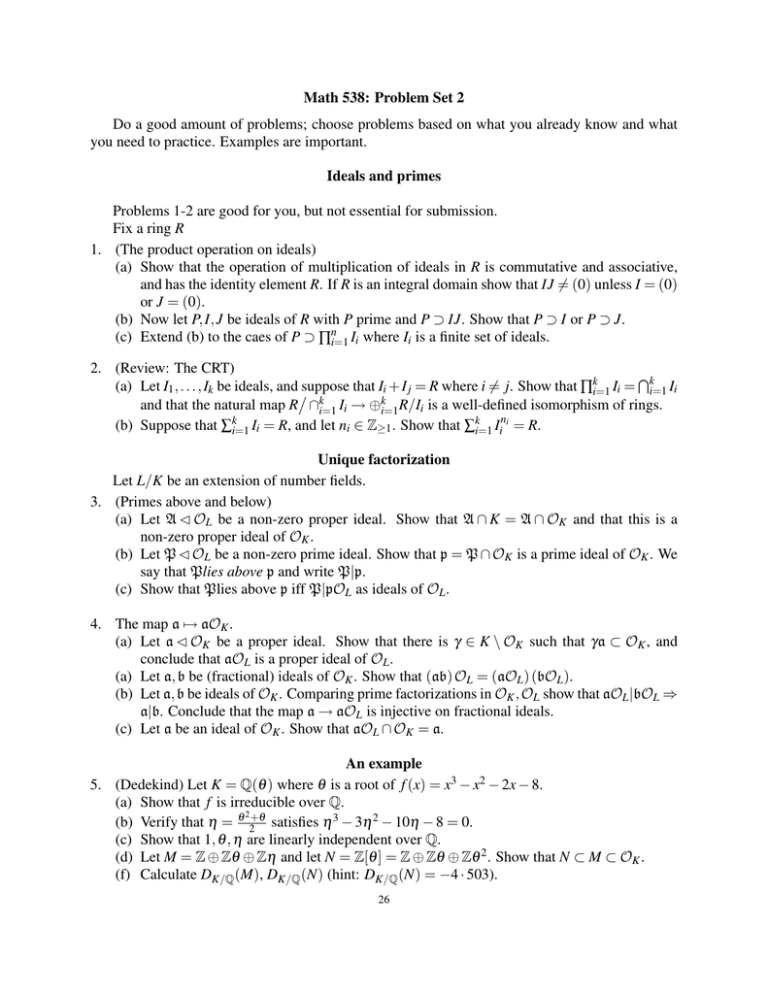
Math 538: Problem Set 2
Do a good amount of problems; choose problems based on what you already know and what
you need to practice. Examples are important.
Ideals and primes
Problems 1-2 are good for you, but not essential for submission.
Fix a ring R
1. (The product operation on ideals)
(a) Show that the operation of multiplication of ideals in R is commutative and associative,
and has the identity element R. If R is an integral domain show that IJ 6= (0) unless I = (0)
or J = (0).
(b) Now let P, I, J be ideals of R with P prime and P ⊃ IJ. Show that P ⊃ I or P ⊃ J.
(c) Extend (b) to the caes of P ⊃ ∏ni=1 Ii where Ii is a finite set of ideals.
2. (Review: The CRT)
T
(a) Let I1 , . . . , Ik be ideals, andsuppose that Ii + I j = R where i 6= j. Show that ∏ki=1 Ii = ki=1 Ii
and that the natural map R ∩ki=1 Ii → ⊕ki=1 R/Ii is a well-defined isomorphism of rings.
(b) Suppose that ∑ki=1 Ii = R, and let ni ∈ Z≥1 . Show that ∑ki=1 Iini = R.
Unique factorization
Let L/K be an extension of number fields.
3. (Primes above and below)
(a) Let A C OL be a non-zero proper ideal. Show that A ∩ K = A ∩ OK and that this is a
non-zero proper ideal of OK .
(b) Let P C OL be a non-zero prime ideal. Show that p = P ∩ OK is a prime ideal of OK . We
say that Plies above p and write P|p.
(c) Show that Plies above p iff P|pOL as ideals of OL .
4. The map a 7→ aOK .
(a) Let a C OK be a proper ideal. Show that there is γ ∈ K \ OK such that γa ⊂ OK , and
conclude that aOL is a proper ideal of OL .
(a) Let a, b be (fractional) ideals of OK . Show that (ab) OL = (aOL ) (bOL ).
(b) Let a, b be ideals of OK . Comparing prime factorizations in OK , OL show that aOL |bOL ⇒
a|b. Conclude that the map a → aOL is injective on fractional ideals.
(c) Let a be an ideal of OK . Show that aOL ∩ OK = a.
An example
5. (Dedekind) Let K = Q(θ ) where θ is a root of f (x) = x3 − x2 − 2x − 8.
(a) Show that f is irreducible over Q.
2
(b) Verify that η = θ 2+θ satisfies η 3 − 3η 2 − 10η − 8 = 0.
(c) Show that 1, θ , η are linearly independent over Q.
(d) Let M = Z ⊕ Zθ ⊕ Zη and let N = Z[θ ] = Z ⊕ Zθ ⊕ Zθ 2 . Show that N ⊂ M ⊂ OK .
(f) Calculate DK/Q (M), DK/Q (N) (hint: DK/Q (N) = −4 · 503).
26
(h) Show that M = OK
Hint: Let {α, β , γ} be an integral basis and consider
dK/Q (1,θ ,η)
dK/Q (α,β ,γ) .
(i) Let δ = A + Bθ +Cη with A, B,C ∈ Z. Show that 2|dK/Q (Z[δ ]), and conclude that Z[δ ] 6=
OK .
Localization
6. (Localization at a prime)
of K.
αLet p C OK be a prime
/ p is a subring of K. It is called the localization of
(a) Show that OK,p = s | α, s ∈ OK , s ∈
OK at p.
(b) Show that pOK,p is an ideal in OK,p , and that its complement consists of (OK,p )× . Conclude that OK,p is a local ring: it has a unique maximal ideal.
RMK The localization of any ring at a prime ideal is a local ring.
(c) Let x ∈ K × . By considering the prime factorization of the fractional ideal (x) show that at
least one of x, x−1 ∈ OK,p .
DEF A subring of a field satisfying the property of (c) is called a valuation ring.
k
(**d) Show that every ideal of OK,p is of the form
x (pOK,p ) for some k≥ 0.
(e) Let L be a finite extension of K. Show that s | x ∈ OL , s ∈ OK \ p is a subring of L (the
localization of OL at p), finitely generated as an OK,p -module, and use the structure theory
n where n = [L : K].
of modules over a PID to conclude that it is of the form OK,p
Completion
7. Let (X, d) be a metric space, X̂, dˆ its metric completion. Let (Y, dY ) be a complete metric
space.
(a) Let f : X n → Y be uniformly continuous on balls: Given z ∈ X and ε, R > 0 there is δ > 0
such that if x, x0 ∈ Rn satisfy for all i that d(xi , xi0 ) < δ for d(z, xi ), d(z, xi0 ) ≤ R then
dY f (x), f (x0 ) < ε .
Show that f extends uniquely to a continuous function fˆ : X̂ n → Y .
(b) Suppse that X is also a group, and that the map (x, x0 ) → x−1 x0 is uniformly continuous.
Show that X̂ has a unique group structure continuosly extending that of X.
(c) In the setting of B, let H < X be a subgroup. Show that the closure of H in X̂ is a subgroup,
and that if H is normal in X then the closure is normal in X̂.
27
